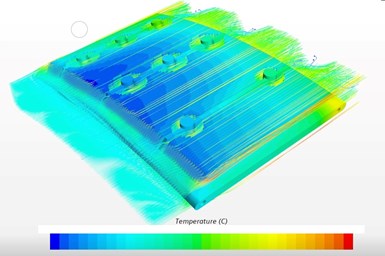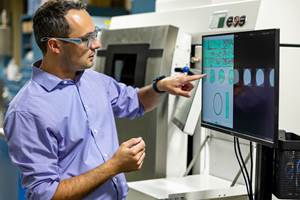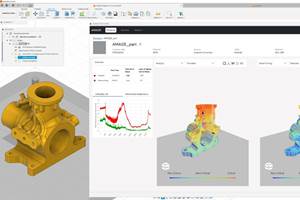PhysicsX, Velo3D Partner to Provide Engineers with AI Simulation Tooling
The collaboration gives Velo3D customers access to AI-enabled physics simulation and optimization capabilities, and gives PhysicsX customers increased manufacturing flexibility to produce their most advanced concepts.
Share
CFD simulation of the thermal behavior of a conformal heat exchanger, used widely in jet-engine cowlings, for a Tier 1 supplier (front edge is blurred to protect IP). The company is using PhysicsX to replace a traditionally manufactured heat exchanger with a 3D printed one. PhysicsX uses its SFAM process (Simulation for Additive Manufacturing) to optimize the additive design to significantly outperform the conventional one. Image Credit: PhysicsX
Velo3D, a metal additive manufacturing (AM) technology company for mission-critical parts, has established a strategic partnership with PhysicsX through Velo3D’s Technical Partner Program. The partnership gives Velo3D customers access to PhysicsX’s artificial intelligence (AI)-enabled physics simulation workflows to hyper-accelerate simulation loops, improve simulation fidelity and algorithmically explore complex design spaces to unlock new performance levels. It also provides PhysicsX customers with access to advanced metal AM capabilities, so they can produce novel, highly optimized part designs with ease.
“We started working with PhysicsX when we were building the Sapphire XC printer because we needed to optimize the flow of gas in the printer build chamber to eliminate soot buildup around the laser windows of the system,” says Benny Buller, Velo3D founder and CEO. “We quickly realized that PhysicsX’s capabilities could be a big boon to many of our customers who are pushing design performance limits. After working closely with them over the past two years, we’ve formalized our partnership to expose customers to the engineering synergy that exists by combining both companies’ technologies.”
Simulation for Additive Manufacturing (SFAM) is a key component of PhysicsX’s processes that makes previously unobtainable part and system performance achievable and manufacturable. Through the use of multiphysics simulation with ultrafast deep learning models, PhysicsX optimizes designs to maximize their performance. Engineers and scientists can now rapidly optimize designs and improve design-to-production processes — from combustion efficiency improvements to manufacturing yield.
It combines traditional computer-aided engineering (CAE) with machine learning capabilities to replicate the physics of various real-world environments. Compared to traditional CAE simulators, it is said PhysicsX’s AI-powered technology can greatly increase the number of design cycles that are possible over a specific time frame and better fill in the gaps of numerical simulation with real-world data — all to find the true limits of the physics behind the challenge. This enables engineers to extensively search a complex design space without imposing simplified design assumptions, and to have the confidence that those designs are reliably manufacturable at high quality.
“PhysicsX supports customers in some of the most important industries of our time, including aerospace, automotive, sustainability and renewables,” says Robin Tuluie, PhysicsX founder and co-CEO. “Our technology can be deployed to evaluate performance in a variety of categories, such as system performance, efficiency, weight, noise and other criteria. Through PhysicsX, engineers have improved reduced emissions from aircraft and road vehicles, won world championships in MotoGP, and increased the performance of wind and hydro turbines. We’re excited about this partnership and that, by working with both PhysicsX and Velo3D, customers will be able to quickly realize unparalleled performance gains for their products without compromising on reliability or additive build quality.”
Velo3D works with a variety of partners, including contract manufacturers, commercial distributors, software and simulation providers, postprocessing solutions and academic institutions to enable customers to build the parts they need, speed up development and reduce product costs. Its Technical Partner Program is focused on providing Velo3D customers with powerful technology and services that complement its fully integrated additive manufacturing solution, so customers can more easily produce optimized final, ready-to-use parts.
- Listen to this episode of AM Radio to learn more about how artificial intelligence and additive manufacturing are connected. Stephanie Hendrixson and Peter Zelinski discuss how there are already plenty of uses of AI in 3D printing for design, process planning and process monitoring, and the link will grow stronger as the “frictionlessness” of AI blends with that of AM.
- Read this post about Visser Precision joining Velo3D’s Global Contract Manufacturing Network. The number of high-performance superalloys certified for AM grows as Visser Precision purchases first Velo3D Sapphire printer calibrated for Hanes 214 — with customers in aerospace, defense, automotive and industrial tooling.
Related Content
AI-Assisted 3D Slicing Software Simplifies Dental 3D Printing Process
The software simplifies the 3D printing process so users don’t need special design training.
Read MoreInspection Method to Increase Confidence in Laser Powder Bed Fusion
Researchers developed a machine learning framework for identifying flaws in 3D printed products using sensor data gathered simultaneously with production, saving time and money while maintaining comparable accuracy to traditional post-inspection. The approach, developed in partnership with aerospace and defense company RTX, utilizes a machine learning algorithm trained on CT scans to identify flaws in printed products.
Read MoreHexagon Invests in Divergent’s Autonomous, Sustainable Manufacturing
The Divergent Adaptive Production System (DAPS) is a fully integrated software and hardware solution, creating a complete modular digital factory that combines AI-optimized generative design software, additive manufacturing and automated assembly to build lightweight automotive parts and frames.
Read More1000 Kelvin’s AMAIZE AI Co-Pilot for Additive Manufacturing Now Available for Autodesk Fusion
The AMAIZE software is an “AI co-pilot” for engineers, predicting print issues upfront, performing corrections and generating industrial-grade, ready-to-use print files specific to a machine.
Read MoreRead Next
4 Ways the Education and Training Challenge Is Different for Additive Manufacturing
The advance of additive manufacturing means we need more professionals educated in AM technology.
Read MoreHybrid Additive Manufacturing Machine Tools Continue to Make Gains (Includes Video)
The hybrid machine tool is an idea that continues to advance. Two important developments of recent years expand the possibilities for this platform.
Read More3D Printing Brings Sustainability, Accessibility to Glass Manufacturing
Australian startup Maple Glass Printing has developed a process for extruding glass into artwork, lab implements and architectural elements. Along the way, the company has also found more efficient ways of recycling this material.
Read More



















